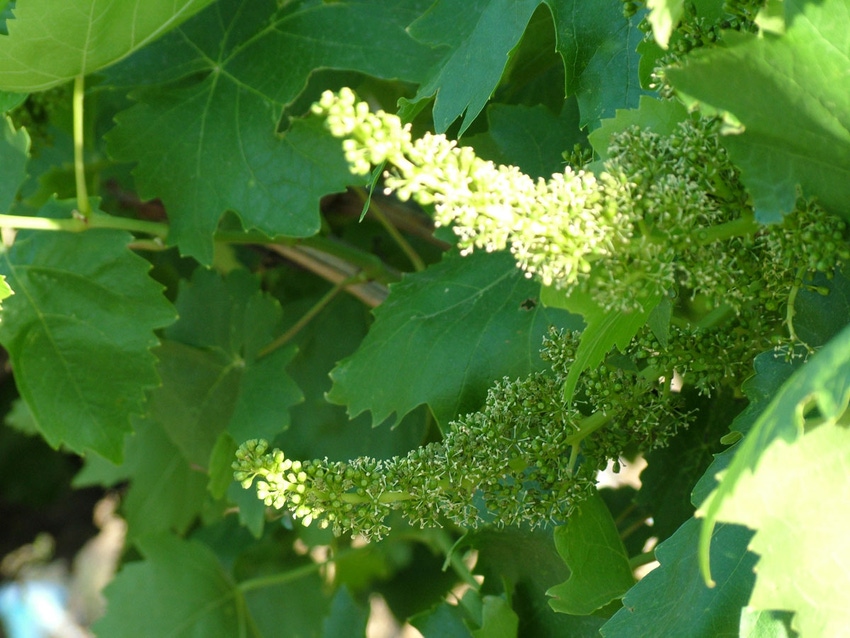
By mid-April shoot growth in the Kautz Family Vineyards in the Lodi appellation of the northern San Joaquin Valley had extended to about 10 to 18 inches in length. That rate of growth is similar to last year, but it’s about two weeks ahead of the usual pace. This follows an earlier-than-normal start of bud break in the third week of February, says Kurt Kautz.
He manages the family’s 5,000 acres of wine grapes which include a number of varieties ranging from Cabernet Sauvignon, Pinot Noir and Petite Verdot to Riesling, Tempranillo and Viognier.
Precipitation in the area since last fall has totaled a little above normal. That includes about an inch of rain that fell in the second weekend of April. Currently, soil moisture levels in his fields are the highest in several years.
By mid-April of last year he had already irrigated his vineyards once or twice. This year, depending on the weather, he may not start running water through his drip irrigation systems until the first or second week of May.
Kautz expects the added soil moisture along with the warming temperatures of spring will fuel more vigorous vine growth than the last several years. That will require earlier canopy trimming to promote more effective coverage when applying sulfur for controlling powdery mildew and improving penetration of sunlight through the foliage.
The added rainfall has also allowed weeds and cover crops, a mixture of barley and clovers, to flourish. “They’re growing pretty darn well,” Kautz says. “In fact, this year, we’ve had to mow the cover crops before incorporating them. However, the moist soils also improve effectiveness of our disking operations to control the weeds and incorporate the cover crops.”
Wells provide the water for irrigating all of his vineyards, Kautz notes. Before the start of the current rain-year, his ground water levels had fallen below average. Now he has his fingers crossed, hoping the increased winter rainfall has pushed those levels up.
He’s taking part in a planned project by the local irrigation district designed to relieve some of the pressure on local supplies of ground water. Under this project, purchased water from the Mokelumne River will be directed into a creek flowing through one of his properties for use in irrigating the vineyard there. “Because we won’t be taking water out of the ground for irrigation, this is a conjunctive use of the river water and is considered the same as recharging the ground water in this area,” Kautz says.
At the same time, he expects to be using less water to bring in a grape crop in the future than he used to. That’s one of his take-home lessons of the past four years of drought. “We’ve learned that our grape vines can do well with a bit less water than we were giving them six or seven years ago,” Kautz says.
He’s most concerned about the availability and expected higher cost of labor to grow his grapes in the years to come. To prepare for that, he’s exploring several options for reducing the need for labor to grow the grapes.
In one trial started two years ago, crews are reducing the number of mature vines tied annually by tying the mature vines every second or third year. “Every reduced pass through the field helps reduce labor costs,” Kautz says.
Another approach uses a tractor-drawn implement equipped with a spinning solid rubber hose-like flail to remove suckers early in the season.
Also, instead of making three trips down the rows with a disk to control weeds and work cover crops into the soil, he’s reduced it to two passes – one with a disk; the other with a toolbar fitted with shanks to break up the soil. He’s experimenting with using the shanks first followed by the disking operations and vice versa, Kautz says.
He reports grape prices being offered to growers in his area this year are similar to last season.
While it’s too early to assess the size of his grape crop this year, Kautz is already seeing some differences in vine development. “In some fields, the vines appear to have a decent number of clusters,” he says. “In others, they look light.”
Kautz and other growers will get their first significant clue following the bloom in May when they count clusters and assess their size and the number of berries that set.
About the Author(s)
You May Also Like




